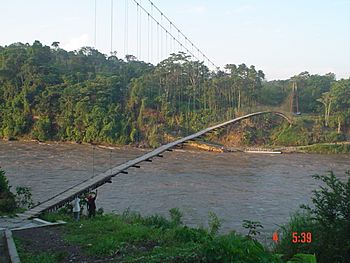Aguarico River facts for kids
Quick facts for kids Aguarico River |
|
|---|---|

A pedestrian suspension bridge crossing the Aguarico
|
|
| Countries | |
| Physical characteristics | |
| River mouth | Napo River 0°58′26″S 75°11′49″W / 0.97389°S 75.19694°W |
| Length | 390 km (240 mi) |
The Aguarico River is an important river in northeastern Ecuador. Its name, "Aguarico," means "rich water" in Spanish. It flows mostly through the Sucumbíos province in Ecuador. For its last part, it forms a natural border between Ecuador and Peru. The Aguarico River eventually flows into the Napo River. It is about 390 kilometers (242 miles) long.
About 50 kilometers (31 miles) of the river's path forms the border between Ecuador and Peru. This border was officially set by an agreement called the Rio de Janeiro Protocol in 1942. The river also flows very close to the Cuyabeno Wildlife Production Reserve, which is a protected area for animals.
River History
In 1541, two explorers named Gonzalo Pizarro and Francisco de Orellana were on an expedition. They built a sailboat called the San Pedro. They traveled along the Coca River and the Napo River.
They reached the point where the Napo River meets the Aguarico River. At this spot, they realized they were running very low on food and supplies. Many of their men did not survive this difficult journey.
On February 22, 1542, they decided that Orellana would continue down the Aguarico River. He took about fifty men with him to search for food. They hoped to find supplies and then return to Pizarro.
However, Orellana found it hard to travel back up the river. Pizarro, meanwhile, had started heading back towards Quito by a different route. Only about 80 of his men were still alive.
Indigenous People of the Aguarico
The Siona people are an indigenous group who live in the upper part of the Aguarico River area. They are part of the western Tucanoan language family. Their main languages are Piohe (or Pioche) and Spanish. Sometimes they speak a mix of both.
Today, there are about 172 Siona people, making up 51 families. They mostly get their food by hunting and fishing. They also sometimes work in tourism, showing visitors their land.
However, the Siona community faces some challenges. These include environmental contamination, which means pollution affecting their land and water. They also deal with over-exploitation of lumber, which is when too many trees are cut down.
See also
 In Spanish: Río Aguarico para niños
In Spanish: Río Aguarico para niños

